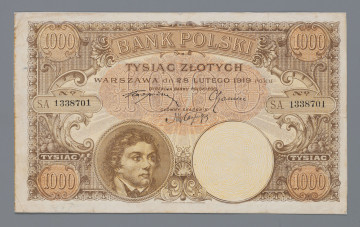
1000 zlotys
1919
National Museum in Lublin
Part of the collection: Paper money during the Second Polish Republic
Following the Act of the Sejm of the Republic of Poland of 28 February 1919, a plan was started to introduce a new Polish currency, which was to replace the money of the Partitioners and the German occupying authorities that was in circulation. In accordance with this decision, the new currency was to be called zloty. In the case of banknotes, it was decided to order their printing outside Poland. The denominations of 1, 2, 5, 10, 20, 50, 100, 500, 1000 and 5000 zlotys were to be circulated. As can be seen, the inflationary experiences of the war years and the first months after regaining independence were reflected in the decision to print PLN 1,000 and PLN 5,000 banknotes. In fact, no official decision to put them into circulation was ever taken. The 500-zloty banknotes, like the 100-, 1000- and 5000-zloty ones, were printed in the London printing house Waterlow & Sons. The lower denominations were produced in the printing works of the Bank of France. The introduction of all denominations was delayed significantly. The difficult economic situation, caused by the need to consolidate the lands that had belonged for a long time to three different partitioning powers, war losses and, above all, the burden of the struggle to maintain the borders, prevented rapid implementation of the Sejm's decision of 28 February 1919. It did not happen until 1924, as part of Władysław Grabski's so-called reform. This was not without legal complications. The banknotes, which had been lying in storage for five years, bore the signatures of people who were not members of the bank's authorities when they were introduced into circulation. The design of the 500-zloty banknote was kept in grey-green. The obverse – like most banknotes from 1919 – featured a portrait of Tadeusz Kościuszko. It is also worth noting the unusual motifs of fruit and vegetables discreetly woven into the decorative elements of both the obverse and the reverse. The banknote measured 180 x 110 mm, so it was significantly larger than its contemporary counterpart.
There are two variants of the 500-zloty banknote, ‘a’ and ‘b’. The main criterion is the height of the digits in the serial number (3.38 or 3.75 mm), but also the length of the numeral (19.5 and 20.7 mm). This banknote is one of 79,233 printed and belongs to the ‘a’ variety, i.e., the one with slightly lower numerals and a shorter numeral.
Leszek Poniewozik
Author / creator
Dimensions
cały obiekt: height: 181 mm, width: 108 mm
Object type
paper money
Technique
Material
paper
Creation time / dating
Creation / finding place
Owner
The National Museum in Lublin
Identification number
Location / status